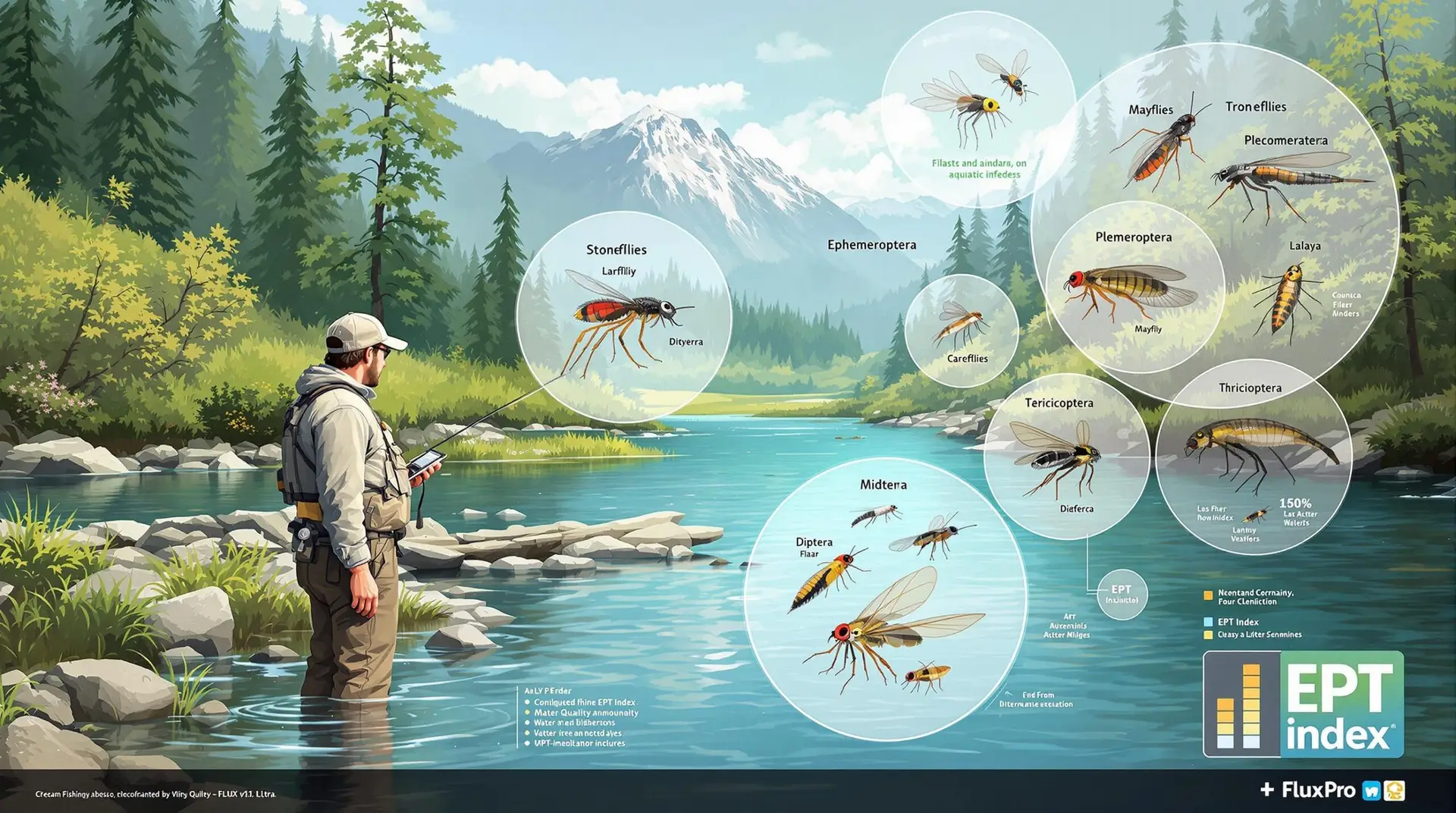Aquatic insects serve as hidden custodians of freshwater environments, maintaining balance by processing dead leaves, controlling algae, filtering particles, stirring sediments, and preying on other organisms. With over 8,600 species in North America, these critical ecosystem components inhabit lakes, ponds, ditches, and streams throughout their life cycles (Virginia Tech Extension).
Key Takeaways
- Benthic macroinvertebrates form crucial links in aquatic food chains, connecting producers to fish
- Macroinvertebrates serve as valuable bioindicators of water quality and pollution levels
- The EPT Index (Ephemeroptera, Plecoptera, Trichoptera) helps assess water health
- Understanding key aquatic insect orders improves fly selection and fishing success
- Matching your flies to local hatch patterns significantly increases catch rates
| Ecosystem Activity | What They Do |
|---|---|
| Leaf Cleanup | Break down dead leaves |
| Algae Check | Nibble on algae |
| Particle Patrol | Filter out bits and bobs |
| Sediment Stirring | Mix up sediments |
| Predator Duty | Snack on other creatures |
Role of Benthic Macroinvertebrates
Let’s talk about benthic macroinvertebrates—think of them as the unsung heroes of aquatic food canteens. This gang includes crustaceans, worms, and mostly aquatic insects. They bridge the gap between humble producers like leaves and algae and the fish that gobble them up (Stroud Center). These guys play a vital part in shuffling nutrients around and making sure energy flows smoothly in streams, lakes, and rivers.
| Benthic Critter | What They Do for Dinner |
|---|---|
| Crustaceans | Link leaves to fish cuisine |
| Worms | Recycle nutrients back to nature |
| Aquatic Insects | Move energy from algae to big fish dining tables |
Grasping how these insects fit into the picture can be a game-changer for fly fishermen. By knowing their roles, anglers can use stream entomology tools to fine-tune their fishing game and possibly reel in the catch of the day.
Stream Entomology Tools
Diving into stream entomology, especially the gadgets of the trade, hands out precious nuggets of wisdom to savvy fly fishermen. Learning how to turn macroinvertebrates into nature’s report card and tapping into the EPT Index for water quality checks can give you the upper hand.
Macroinvertebrates as Bioindicators
Think of macroinvertebrates as the tiny critter squad that lives in water and reveals secrets about the quality of their watery home. With little effort, these guys can be scooped up to serve as trusty bioindicators. Thanks to their sluggish nature, they paint a long-term picture of pollution.
| Feature | Perk |
|---|---|
| Easy to find | Simplifies the job of monitoring |
| Not too mobile | Spotlights long-term pollution |
| Big mix of species | A wide palette of water indicators |
The presence of certain bugs—or lack thereof—gives away clues on pollution levels or habitat tweaks in freshwater hangouts (Virginia Tech Extension). While these little detectives give quick reads on water quality, they can’t pinpoint specific nasties. For that, you’d need to roll out the big guns with physical and chemical tests.
EPT Index for Water Quality Assessment
The EPT Index, short for Ephemeroptera (mayflies), Plecoptera (stoneflies), and Trichoptera (caddisflies), is a popular go-to for checking water health (Ausable River Association). These bugs each have different levels of pollution durability, making them spot-on for evaluating aquatic health.
| EPT Group | Pollution Tolerance | Higher Score Indicates |
|---|---|---|
| Ephemeroptera | Low | Top-notch Water Quality |
| Plecoptera | Low | Top-notch Water Quality |
| Trichoptera | Middle-of-the-road | Pretty Good Water Quality |
Score high on the EPT Index, and you’re lookin’ at cleaner waters with less muck (Ausable River Association). Anglers can take advantage of this info to tweak their game plan and aim their rods at areas boasting clearer waters for a better catch.
By meshing the know-how of macroinvertebrates as water-quality tattletales and the EPT Index, seasoned fly fishermen can crack open new layers of stream secrets, helping them reel in top results.
Angling Entomology Basics
Identifying Key Aquatic Insect Orders
Angling entomology’s all about figuring out which bugs make fish go bonkers. Knowing these buggy groups means you can whip up flies that fish can’t resist, just like the real critters darting around their watery homes.
Let’s check out four insect pals important for fishing, with both their funny quirks and fab features:
- Mayflies (Ephemeroptera):
- Juveniles: Sporting three fancy tails and gills down their bods.
- Grown-ups: With upright wings and lightweight frames, plus those iconic tails—two or three of ’em.
- Stoneflies (Plecoptera):
- Youngsters: Dancing around with two tails and gills up near the shoulders.
- Adults: They chill with flat wings resting on their backs, rockin’ two tails too.
- Caddisflies (Trichoptera):
- Larvae: Busy building cases or just hanging out with some serious butt hooks.
- Big Guys: They resemble tiny moths with tent-like wing arrangements.
- Midges (Diptera):
- Kids: Looking all wormy, sans legs and all.
- Grown-ups: They stay teeny and typically sport just a pair of wings.
| Order | Common Name | Groovy Larval Traits | Adult Looks |
|---|---|---|---|
| Ephemeroptera | Mayflies | Triple tails, gilled | Wings up high, sporting tails |
| Plecoptera | Stoneflies | Double tails, thorax gills | Wings flat, twin tails |
| Trichoptera | Caddisflies | Makers or freeriders, rear hooks | Tent-like wings |
| Diptera | Midges | Worm-esque and leg-free | Petite, pair of wings |
Latin Names for Clarity in Communication
When chitchatting about bugs, throwing out their Latin tags means less mix-up and more high-fives among fishers. These fancy names give everyone a clear picture, bypassing the regional name game.
They also spill some insider tea on what the bugs are about. Peep these examples:
- Ephemeroptera (Mayflies): “Ephemera”—fickle or brief, “ptera”—wings.
- Plecoptera (Stoneflies): “Pleco”—woven together, hinting at wing texture.
- Trichoptera (Caddisflies): “Trich”—hair, “ptera”—wings, showcasing the fuzziness.
- Diptera (Midges): “Di”—two, “ptera”—wings, highlighting their duo-wing status.
Using the Latin lingo means smoother convos, especially when shooters from different necks of the woods are in on it. All this keeps everyone on the same page, and no one’s left guessing what’s buzzing.
| Order | Common Name | Latin Name | Meaning |
|---|---|---|---|
| Ephemeroptera | Mayflies | Ephemeroptera | Short-lived wings |
| Plecoptera | Stoneflies | Plecoptera | Woven winged |
| Trichoptera | Caddisflies | Trichoptera | Fuzzy wings |
| Diptera | Midges | Diptera | Double-winged |
Fishing Tips with Insect Matching
When you’re out there hoping to catch more fish than tales, knowing how to mimic those little critters fish munch on can really up your fly fishing game. Let’s get into some tips for picking the right nymphs and tweaking your style based on what’s popping in the water.
Picking the Right Nymph for the Job
Getting the right imitation is crucial, especially when fish are picky about their dinner menu. Think of yourself as a detective, using the local hatch charts to sleuth out when and what bugs are buzzing around. This intel can be your golden ticket to picking the right disguise for your lure.
In Montana, for instance, folks have snagged quite the catch at Clark’s Fork River by using nymphs that copycat stoneflies—a favorite on the fishes’ menu. Imagine reeling in a beefy three-pound cut-bow just because you got the dinner invite right (Fly Fisherman). Nailed it, right?
Now, if you’re aiming for deeper waters, think heavy. A pattern that mimics bugs like stoneflies or mayflies and a lengthy 12-foot leader can get your fly down where the big guys are hanging out (Fly Fisherman).
Switching Tactics with Hatch Times
Changing up your approach based on when these bugs decide to make an appearance can change your fishing fortunes. Knowing their little life habits can help you tweak your game and boost your chances.
For instance, shift to darker flies like a rusty Yellow Stonefly Nymph when the sun clocks out. It’s been known to trigger more action from the fish than paler options when fishing under the moonlight (Fly Fisherman). Mix up your patterns and split your time into short, focused sessions, and you might see a big leap in your catch rate.
So, here’s a cheat sheet to make the most of what you’ve got:
- Scope out Hatch Charts: Peek at those hatch charts to sync up with when your quarry’s on the menu.
- Get Heavy with It: For depth, go for heavier nymphs paired with long leaders – just like serving up dessert after dinner.
- Shade Swapping: Tune your fly’s shade to match the lighting—dark for the dark, light for the day.
Quick Reference Table:
| Tactic | Action | Why It Works |
|---|---|---|
| Hatch Chart Intel | Consult regional charts | Aligns your lure with what’s on the fishes’ menu (The Scientific Fly Angler) |
| Heavy Nymphs | Use a 12-foot leader for the deep dive | Reaches deeper-set fish (Fly Fisherman) |
| Shade Switch | Opt for darker flies when the moon’s out | Boosts strikes when fishing after dark (Fly Fisherman) |
Using these tips, you’re set to make your fishing trips not only successful but a whole lot more fun, leaving you with a bigger catch and an even bigger smile.

